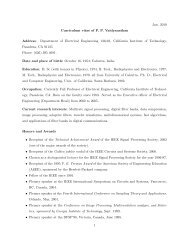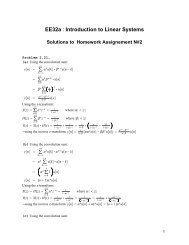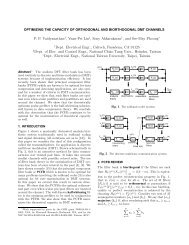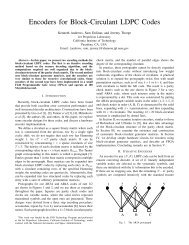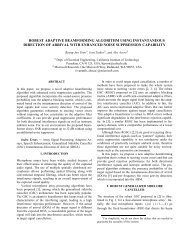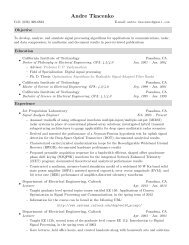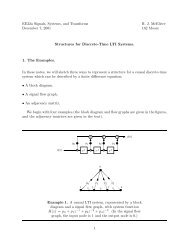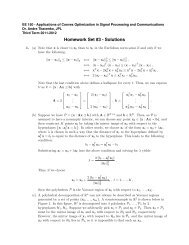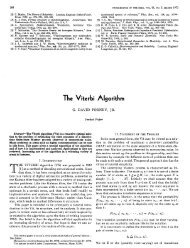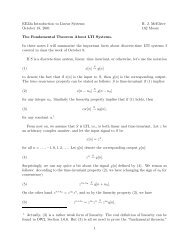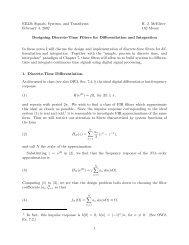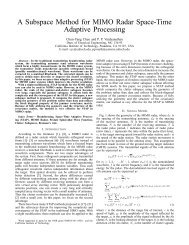Homework Set #1 - due on April 12 in class
Homework Set #1 - due on April 12 in class
Homework Set #1 - due on April 12 in class
You also want an ePaper? Increase the reach of your titles
YUMPU automatically turns print PDFs into web optimized ePapers that Google loves.
EE 150 - Applicati<strong>on</strong>s of C<strong>on</strong>vex Optimizati<strong>on</strong> <strong>in</strong> Signal Process<strong>in</strong>g and Communicati<strong>on</strong>sDr. Andre Tkacenko, JPLThird Term 2011-20<strong>12</strong>Due <strong>on</strong> Thursday, <strong>April</strong> <strong>12</strong> <strong>in</strong> <strong>class</strong>.<str<strong>on</strong>g>Homework</str<strong>on</strong>g> <str<strong>on</strong>g>Set</str<strong>on</strong>g> <str<strong>on</strong>g>#1</str<strong>on</strong>g>1. (10 po<strong>in</strong>ts) Send a brief message with your name <strong>in</strong> full to the course e-mail address(ee150.acospc@gmail.com) <strong>in</strong> order to get <strong>on</strong> the mail<strong>in</strong>g list.2. (10 po<strong>in</strong>ts) (Young’s <strong>in</strong>equality for products, Hölder’s <strong>in</strong>equality, and M<strong>in</strong>kowski’s<strong>in</strong>equality:) The goal of this problem is to prove several useful <strong>in</strong>equalities for the l p -norm.Each of the <strong>in</strong>equalities referenced above can be proved us<strong>in</strong>g the <strong>on</strong>e previously menti<strong>on</strong>ed(except, of course, for the first <strong>on</strong>e).(a) (Young’s <strong>in</strong>equality for products:) Suppose p, q > 0 are such that 1 p + 1 qprove thatab ≤ app + bqq ,with equality if and <strong>on</strong>ly if a p = b q .= 1. If a, b ≥ 0,H<strong>in</strong>t: Use the fact that the exp<strong>on</strong>ential functi<strong>on</strong> is c<strong>on</strong>vex, which implies that for0 < θ < 1, we have e θx+(1−θ)y ≤ θe x + (1 − θ)e y , with equality if and <strong>on</strong>ly if x = y.(b) (Hölder’s <strong>in</strong>equality:) Let x, y ∈ C n with x k = [x] kand y k = [y] kfor 1 ≤ k ≤ n. Showthatn∑|x k y k | ≤ ||x|| p||y|| q,with equality if and <strong>on</strong>ly if |x k| p||x|| p pk=1= |y k| q||y|| q qfor all 1 ≤ k ≤ n.(c) (M<strong>in</strong>kowski’s <strong>in</strong>equality:) Suppose that x and y are as <strong>in</strong> part (b). Prove that||x + y|| p≤ ||x|| p+ ||y|| p,with equality if and <strong>on</strong>ly if x k = λ k y k or y k = λ k x k for some λ k ≥ 0 for all 1 ≤ k ≤ nfor p = 1 and x = λy or y = λx for some λ ≥ 0 for p > 1. This is the triangle<strong>in</strong>equality for the l p -norm.H<strong>in</strong>t: First show that |c + d| ≤ |c| + |d| for c, d ∈ C with equality if and <strong>on</strong>ly if c = Kdor d = Kc for some K ≥ 0 (this is the triangle <strong>in</strong>equality for complex scalars). Thenapply Hölder’s <strong>in</strong>equality (twice) and trace back all of the c<strong>on</strong>diti<strong>on</strong>s required forequality.3. (10 po<strong>in</strong>ts) (Dual of the l p -norm:) If ||·|| is a norm <strong>on</strong> C n , recall that, for the standard <strong>in</strong>nerproduct, the dual norm ||·|| is def<strong>in</strong>ed as follows:{ [ ] }||z|| = sup Re z † x : ||x|| ≤ 1 .Suppose that p, q > 0 and satisfy 1 p + 1 q = 1. Prove that the dual of the l p-norm ||·|| pis thel q -norm ||·|| q.
H<strong>in</strong>t: Use the equivalent formulati<strong>on</strong> of the dual norm given by{∣ }∣∣z||z|| = sup † x∣ : ||x|| = 1 ,al<strong>on</strong>g with Hölder’s <strong>in</strong>equality from the previous problem to show that ∣ ∣z † x ∣ ∣ ≤ ||z|| q. Thenf<strong>in</strong>d a clever choice of x to achieve equality.4. (10 po<strong>in</strong>ts) (Block matrix <strong>in</strong>versi<strong>on</strong> and the matrix <strong>in</strong>versi<strong>on</strong> lemma:) Let A, B, C, and Dare matrices of dimensi<strong>on</strong>s m × m, m × n, n × m, and n × n, respectively. Suppose that Aand D are <strong>in</strong>vertible. This problem deals with the (m + n) × (m + n) block matrix M givenby[ ]A BM =.C D(a) Show the follow<strong>in</strong>g two identities:[] [ ] [ ]I m 0 m×n A B Im −A −1 B−CA −1 I n C D 0 n×m I n[ ] [ ] []Im −BD −1 A B I m 0 m×n0 n×m I n C D −D −1 C I n==[A0 m×n0 n×m D − CA −1 B[A − BD −1 C 0 m×n0 n×m D]] .(b) Us<strong>in</strong>g part (a), show that[] [I m 0 m×n A 0 m×nM =CA −1 I n 0 n×m D − CA −1 B[ ] [Im BD −1 A − BD −1 C 0 m×n=0 n×m I n 0 n×m D] [ ]Im A −1 B0 n×m I n] [] .I m 0 m×nD −1 C I nFrom this result, show that we havedet(M) = det(A) det ( D − CA −1 B ) = det ( A − BD −1 C ) det(D) .H<strong>in</strong>t: For the first part, use the fact that[ ] −1 [ ]Im FIm −F=0 n×m I n 0 n×m I nand[ ] −1 [ ]Im 0 m×n Im 0 m×n=,G I n −G I nfor any m × n matrix F and n × m matrix G. To help with the sec<strong>on</strong>d part, use thefact that([])R 0 m×ndet(PQ) = det(P) det(Q) and det= det(R) det(S) ,0 n×m Sfor any k × k matrices P and Q, as well as any m × m matrix R and n × n matrix S.
Notice that Σ v is the Schur complement of Σ y <strong>in</strong> Σ z .H<strong>in</strong>t: From our knowledge of c<strong>on</strong>diti<strong>on</strong>al probability, the pdf of v, denoted f v (v), is given by( [f v (v) = f (x,y)(x, y 0 ) f z vTy T ] ) T0=,f y (y 0 )f y (y 0 )where f y (y 0 ) is the pdf of y evaluated at y 0 , which can be obta<strong>in</strong>ed us<strong>in</strong>g the multivariateGaussian distributi<strong>on</strong> expressi<strong>on</strong> above as it can be shown that y ∼ N ( µ y , Σ y). Also, besure to use the results from the previous problem.Read<strong>in</strong>g assignments:1. Look over parts of The Matrix Cookbook as needed and start read<strong>in</strong>g the cvx Users’ Guide.Rem<strong>in</strong>ders:Late homework policy for EE 150: Late homeworks will not be accepted. There will be noexcepti<strong>on</strong>s to this other than <strong>in</strong>stitute established emergency reas<strong>on</strong>s, <strong>in</strong> which case a signedletter is required from an authorized official.NCT Problems: Remember that problems with an asterisk, such as *7 are no collaborati<strong>on</strong> type(NCT) problems.Texts: The abbreviati<strong>on</strong> CO-BV corresp<strong>on</strong>ds to the textbook “C<strong>on</strong>vex Optimizati<strong>on</strong>” by StephenBoyd and Lieven Vandenberghe. In additi<strong>on</strong>, CO-AE refers to the Additi<strong>on</strong>al Exercises forC<strong>on</strong>vex Optimizati<strong>on</strong>, also by Boyd and Vandenberghe. F<strong>in</strong>ally, CVX corresp<strong>on</strong>ds to the cvxUsers’ Guide by Michael Grant and Stephen Boyd.



